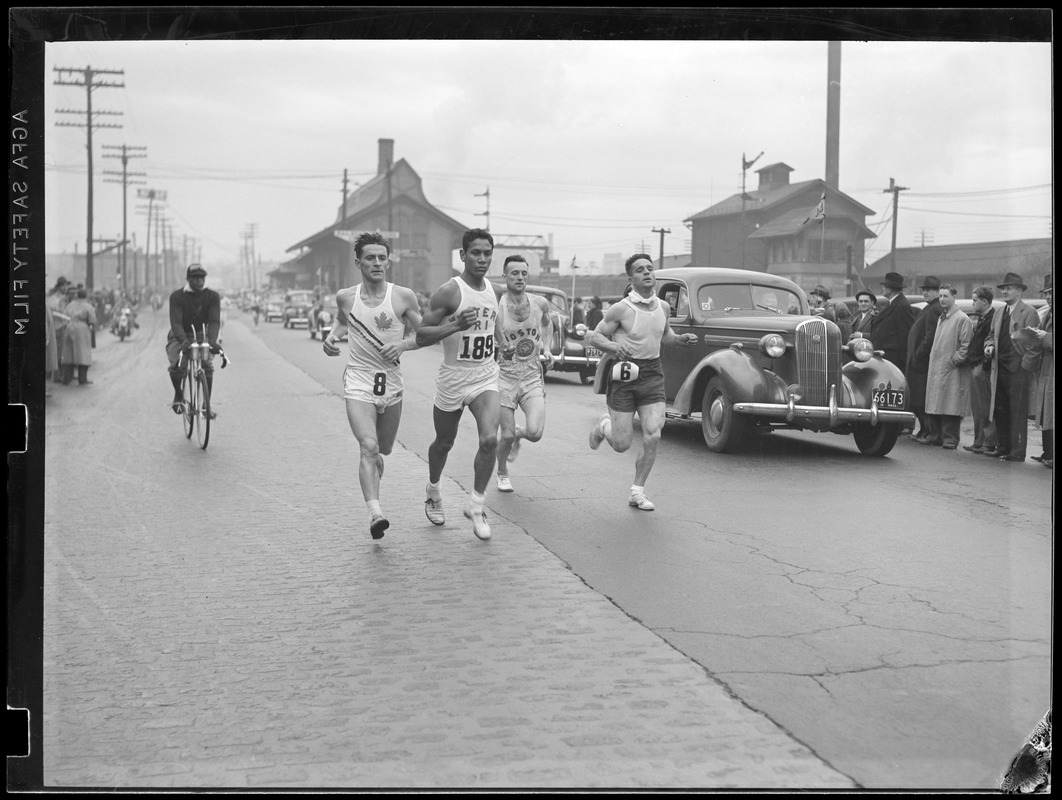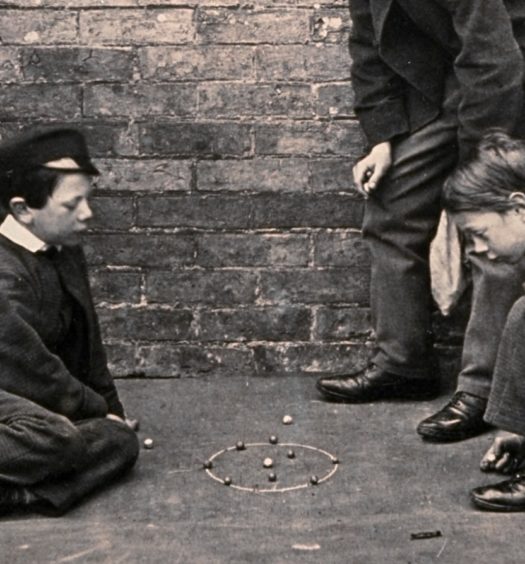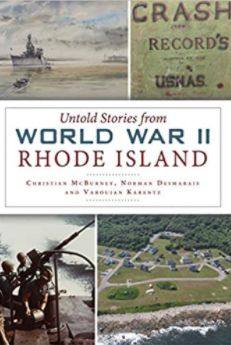In his first major foot race, the Boston Marathon in 1935, at the age of twenty, Ellison “Tarzan” Brown came out of nowhere. He was a poor Narragansett Indian from Charlestown, residing on Narragansett tribal land. He managed to pay the $1 entrance fee. He wore a tunic fashioned by his sisters from a dress owned by his mother, who had passed away within the month. He was raw and clearly had had little formal training. But he had a strength, a natural grace and grit that could not be taught. Getting rid of his old sneakers with seven miles to go and resorting to his bare feet, Brown finished in thirteenth place.
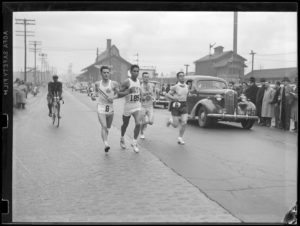
Ellison “Tarzan” Brown (No. 189) running in the 1939 Boston Marathon, wearing a Westerly R I shirt (Leslie Jones Collection, Boston Public Library)
So began the legendary long-distance running career of Tarzan Brown. This was a time when the sport of running marathons, 26.2 miles long, was heavily covered by the press. It was before professional football, basketball and hockey became major sports. Runners such as Clarence DeMar, Johnny Kelley, and Pawtucket’s Len Pawson were then making the Boston Marathon a major sporting event by injecting speed into the race. Before them the marathon was considered mainly a test of endurance. Then Brown came along and ran even faster.
Before he finished his running career in 1944, Brown achieved the following remarkable achievements. He won the Boston Marathon in 1936 and 1939, and for years held the speed records for all seven checkpoints from start to finish. He set the world’s record for fastest time in a marathon twice, once in Boston and another time in Lawrence. He also won three national championships at shorter distances than marathons, and won more than two dozen other events ranging from ten to sixteen miles. Astonishingly, the muscular 5-foot-7, 138-pound Narragansett tribe member once won two significant marathon races on two successive days, within 24 hours of each other, a feat that has probably never been matched and never will be.
Ellison Myers Brown was born in poverty in the Potter Hill section of Westerly on September 22, 1913. He grew up in Alton, Rhode Island, a small mill village in the southwest corner of the town of Richmond. His parents, Byron Otis and Grace Ethel (Babcock) Brown, were members of the Narragansett tribe. From his earliest years, he showed a fondness for running and mischief. At age nine he would run outside the yard and down the street only in his underpants, chased by family members. His sister, one of eight siblings, recalled how he received his nickname. “He was 11 and 12 years old and he was always running and swimming and then he was always diving out of trees when he went swimming.” She continued, “Tarzan was always in the movies then, swinging in the trees, and all those boys in Alton gave Ellison the name Tarzan.”
Tarzan was influenced by his uncle, Horatio Stanton, who became a successful runner in the 1920s. Later Stanton became chief of the Narragansett tribe. Once Stanton ran twelve miles to meet his track coach, Thomas “Tippy” Salimeno of Westerly. When Salimeno arrived, Stanton informed him that a young boy was following him for the twelve-mile run. A few minutes later Brown appeared, panting. He was a prospect, Stanton said. The boy, of course, was Tarzan Brown.
Brown grew up poor in rural Charlestown. He attended a one room schoolhouse. Still, he enjoyed fishing, quahauging, and playing in the woods. He showed talent as an artist. His mother carefully watched over him, having lost her first son. But then Tarzan lost her in 1935.
Brown trained hard in preparation for the 1936 Boston Marathon. He remembered his mother’s words, “They’re making fun of you. Show them.” He did.
In the 1936 Boston Marathon, Brown sped out to an early lead. He set such a blistering pace that the press car followed the wrong runners for five miles, not realizing that Brown had sprinted out ahead of the pack. Brown began running up the famous hills at Newton. “I was fresh as a daisy,” he recalled. “I knew if I could get over the first hill, there was only one more to climb.”
Then Johnny Kelley, the defending champion from Arlington, Massachusetts, made his move going up the Newton hills and finally catching Brown at Hammond Street. As he passed Brown, Kelley reached out to pat Brown on his rear end. Kelley later said that he meant no disrespect; perhaps he did it out of respect. A peeved Brown took off and sped by Kelley, leaving him far behind. A newspaper reporter the next day called the final hill where Brown had broken Kelley’s spirit as Heartbreak Hill. The legend of Heartbreak Hill was born.
The courageous Irish-American was not finished yet. Kelley overtook Brown one more time, but it left him completely spent. Brown caught and passed Kelley a second time. Brown then left Kelley and the rest of the field so far in the dust that by Kenmore Square the exhausted Brown was able to slow to a walk. Still, he won the race easily. A Boston newspaper, using a remarkable collection of politically incorrect terms, included in the next day’s edition, “Ellison Myers (Tarzan) Brown, a full-blooded Narragansett, stalked upon the warpath yesterday. . . [and] racing the panting palefaces into the smoldering macadam behind him, the Rhode Island redskin won the 40th annual BAA Marathon in 2 hours, 33 minutes and 40 4/5th seconds.”
The stunning victory meant that Brown automatically qualified for the U.S. Olympic team scheduled to compete in the 1936 Olympic games at Berlin, Germany, later that summer. In addition to the great African American speedster and long jumper Jesse Owens, Adolf Hitler would fear the threat posed by the Narragansett Indian, Tarzan Brown. Brown caught the attention of the press and the public and he temporarily became a celebrity.
Brown’s Olympic experience in Germany was, however, a disappointment. As he did in Boston, Brown sprinted out to the lead. He faltered a bit and fell into fifth place by the half-way mark, but was still within striking distance. At the eighteen-mile mark, disaster struck. A cramp in his calf became so debilitating that Brown stopped and tried to rub it out. A well-meaning German bystander tried to help, also rubbing his calf. Just then an officious German marathon official drove up and declared that Brown was disqualified as a result of receiving outside assistance. A disappointed Tarzan saw no sense in continuing running, so he ended his race. He would have made a better decision to finish the race as best he could, and perhaps challenge the ruling, as the help he received had not been requested. Back in the United States, some called him a quitter.
Brown later recalled to a journalist:
I didn’t know then it was a rule, but I later found out it was. Anyway, there was no point in finishing the race if I was disqualified. I could have won that Olympics if I’d had somebody to advise me right. I made the Olympic team by winning the Boston Marathon back in April. I didn’t have to do any more running to get on the Olympic team, so for two months I just loafed around. What I know now is, I should have kept on racing, staying sharp, If somebody’d told me right I’d have known early that I’d have only nine days’ training when we got off that boat in Germany. Nine days isn’t much time to train for a big race like the Olympics, but I still think I’d have won it easy if I hadn’t cramped up at 18 miles.
To show his critics he was not a quitter, in October 1936, Brown decided to try to accomplish an incredible feat. He registered for the Port Chester, New York, marathon that started on a Saturday at noon, and he submitted his entry for a race at 10 a.m. the following morning in Manchester, New Hampshire. Many of the country’s best marathoners also registered for one or the other race, including the great Clarence DeMar at Manchester. Amazingly, Brown won both races, breaking the course records at both Port Chester and Manchester.
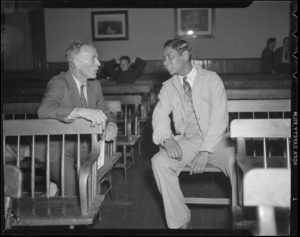
Two great marathoners discuss their matches: Tarzan Brown and Clarence DeMar (Leslie Jones Collection, Boston Public Library)
Brown had competed in the Olympics and that October suffering from a pain in his stomach. He ignored the pain and ran through it; it almost cost him his life. Brown later recalled:
It wasn’t until one day when I was out training, maybe 20 miles from Westerly, when all this pain hit me again, only this time it was tearing at me. I knew something was real bad. I was all doubled up at the side of the road when this guy in a car found me. A half hour later I was on the operating table in the Westerly hospital. I got me a strangulated hernia. I never even heard of one before, and I had been running 15, 16 races with one.
Brown recovered from the hernia operation, but he took a break from racing. In 1937, training for just eleven days for the Boston Marathon, he finished 37th.
Brown did not reach his potential because he was not properly trained. He used to say that in addition to running long distances, his training consisted of chopping wood and halting his visits to local bars. Once before a race, he wolfed down hot dogs and drank soda, saying he had forgotten to eat breakfast that morning. One track expert who saw Brown run thought he should have entered shorter distances to maximize his great speed. “Properly trained and coached,” the expert observed, “this young man might easily be an Olympic champion at 10,000 meters (six miles).”
Brown returned to racing in 1939, training hard running the roads of South County in preparation for that year’s Boston Marathon. His hard work paid off. The fastest Boston Marathon ever had been run by Les Pawson of Pawtucket in 1933. Brown won the 1939 Boston Marathon, in a cold, driving rain, shattering Pawson’s record by more than two minutes. Pacing himself perfectly, Tarzan was virtually unchallenged, becoming the first runner in the race’s history to break the two-and-a-half-hour mark with a time of 2 hours, 28 seconds, and 51 seconds.
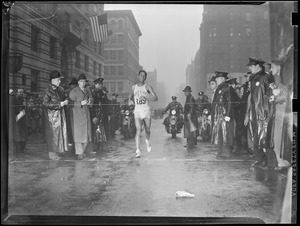
Tarzan Brown on his way to winning the 1939 Boston Marathon, his second in four years (Leslie Jones Collection, Boston Public Library)
Brown’s 1939 Boston Marathon victory would be the last great running achievement in his life. He needed to win the 1940 Boston Marathon to make the U.S. Olympic team, but leg cramps forced him to end the race before he could finish. In any event, World War II led the Olympics that year to be cancelled.
Brown had frequent money problems. During the Great Depression, even though marathons caught the attention of the public, there were no cash purses. Today running purses for winning major marathons can be in the hundreds of thousands of dollars. Once, when Brown won a race and received a trophy, he was bitter that the second-place winner received a watch, which at least be resold.
Sometimes winners could get good job offers. After winning the 1939 Boston Marathon, Brown told reporters, I hope that my victory in this run will get me a steady job. Walter Young got a job as a policeman after he won the Marathon a couple of years ago. I would like to do the same.” Les Pawson of Pawtucket had worked as a weaver in a textile mill before he won the Boston Marathon in 1933. After his victory, the parks department in Pawtucket hired him. He kept the job for years. Brown did not have similar fortune. Was he a victim of discrimination as an Indian? He got a job working on a road gang in Charlestown. Later he became a stone mason, a traditional trade of the Narragansetts to this day. But work was intermittent and he had to take other odd jobs. He was often short of money.
Bob Mar of the Westerly Sun presciently observed in 1996, “With proper training and guidance, and with money as further incentive [to win marathon races], there’s no telling how great Tarzan might have been in this day and age.”
Brown did not hide that he had a drinking problem. In 1948, Brown even admitted to some drinking and fighting at the 1948 Olympics. He said it happened after his marathon event. “I had a jam in Berlin, Germany,” he conceded, “and it was a day or so after I ran the Olympic marathon in ’36. I got celebrating a little and some men in white coats tried to put me out of the place. They didn’t do too good, and the next thing I knew, a half-dozen guys in black shirts were after me. I guess they took care of me.” With his dark Native American skin, the Nazi guards likely gave Brown a good pummeling.
After Brown stopped running competitive races in 1944, his life became a struggle. In 1966, a Boston reporter described him as “living in a tarpaper shack in the wilderness solitude of Charlestown.”
Brown always remained popular with fellow Narragansett tribesmen. His nephew, Russell Spears, while acknowledging his struggles, spoke of times when Brown would take him fishing and on long walks through tribal lands. “He was always laughing,” said his nephew. “He was full of life.” Harry Mars remembered Brown’s love for the Narragansett lands in Charlestown. “He would look at a tree or a bush or a bird . . . like the average man looks at a beautiful woman.”
Ethel Wilcox Brown, who married Tarzan in 1936 and became the mother of his four children, told a story that she thought typified him. She told a journalist, “Ellison would be coming across the field from fishing and he’d see a pretty wild flower, and he would pick it and bring it home to me.” But sometimes Brown’s love of the outdoors and nature interfered with his work. “He could be cutting wood or something,” his daughter recalled, “and then you’d see him look up in the air or over in the woods. Then he’d put the ax down and we wouldn’t see him for a while. It could be two hours, it could be two days.” Ethel claimed that this behavior did not bother her “because that’s the way he was,” but it must have been difficult for his family.
Al Goddard recently recalled that in the 1960s, “I would frequently run into Tarzan as he was always on Kings Factory Road. I could have listened to his accomplishments and his hunting stories forever. He never did brag about his marathon days but rather liked to live in the now and not then.”
By the end of his life, Brown had sold all of his trophies from his marathon days. His wife Ethel said, “He hocked them to buy food” for his family’s table. The ribbons and articles that Brown did not sell he intentionally destroyed in a fire. “I don’t know why” he did it, his daughter recalled, “that was my dad’s personality.”
Brown was tragically killed at age 61, on August 23, 1975. While the facts are murky, it appears that he happened upon a brawl between two groups of men outside a Misquamicut bar. One of the participants, a 26-year-old Connecticut man, trying to leave the scene in his car, accidently ran Brown over. About five hundred persons attended his funeral service at Buckler Funeral Home in Westerly. Some were angry at the white man who had killed him, but Ethel insisted there be no retribution.
Nine months earlier, Brown had been inducted into the American Indian Hall of Fame in Albuquerque, New Mexico. He had been inducted into the Rhode Island Heritage Hall of Fame in 1968.
By 1981, Tarzan’s widow, Ethel Wilcox Brown, was collecting all the articles, stories and memorabilia she could about her deceased husband. “There’s nothing left,” she said, “to show our grandchildren someday, so they’ll know Ellison was a great runner. All I can do is collect all the stories and clippings I can find and put them in a scrapbook. Do you think people will remember him?”
Ethel should not have worried about Ellison Brown’s legacy. He will be always be remembered in Rhode Island, by students of the Boston Marathon, and by the Narragansett tribe.
[Banner image: Ellison “Tarzan” Brown on his to winning the 1939 Boston Marathon (Leslie Jones Collection, Boston Public Library)]
Bibliography
[This article was mostly done reviewing newspaper articles, but the best work, by far, on Tarzan Brown is: Michael Ward, Ellison “Tarzan” Brown, The Narragansett Indian Who Twice Won the Boston Marathon (McFarland, 2006).]“Rhode Island’s Tarzan: The Legends Remain,” by Mike Szostak, Providence Journal, April 14, 1979.
“The Best,” by Bill Rodriguez, Providence Sunday Journal, April 18, 1981.
“Today’s Runners Should Say Thanks,” by Bob Marr, Westerly Sun, April 14, 1996.
“Born to Run,” by Jerry Nason, Yankee Magazine, April 1981.
“Tarzan Brown,” by Michael Madden, Boston Sunday Globe, April 14, 1996.
“The Legend of Tarzan Brown,” Parts I and II, by Zachary Garceau, Westerly Life, March 13, 2019, accessed at https://westerlylife.com/the-legend-of-tarzan-brown-part-i and https://westerlylife.com/the-legend-of-tarzan-brown-part-ii. (This two-part article relies heavily on contemporary Westerly Sun articles).

